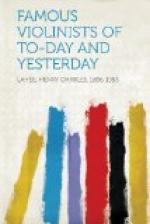Joachim remained in Leipzig until 1850, studying with Ferdinand David, while Hauptmann gave him instruction in composition, though during this time he occasionally travelled in Germany and elsewhere to play in concerts. Thus in 1844 Mendelssohn brought him to England, where he played in public for the first time at a benefit concert of Mr. Bunn’s at Drury Lane, in March, 1844, and in May of the same year he appeared at the fifth Philharmonic concert and played Beethoven’s concerto with very great success. In this year two other violinists of note made their first appearance at the Philharmonic concerts,—Ernst and Sainton, also Piatti, the great violoncellist. Joachim visited England again in 1847, and since that time so frequently that he became one of the regular features of musical life in that country, where he has been so highly honoured.
Joachim’s first appearance in Paris was made in 1849, when he spent two months in that city, and began his successes by playing in an orchestral concert given by Hector Berlioz. About this time Franz Liszt, who had heard of Joachim’s rapidly increasing reputation, invited him to go to Weimar and lead the orchestra which he conducted. Joachim accepted the invitation and remained in Weimar two years. He could never be brought to see the beauty of the new school of music, and while he recognised the extraordinary gifts, and admired the personality and brilliant qualities of Liszt, he could not be prevailed upon to remain in Weimar longer than two years.
In 1854 he accepted the post of conductor and solo violinist to the King of Hanover, a position which he retained for twelve years, during which time he enhanced his reputation as a musician, and married Amalia Weiss, a celebrated contralto singer. In 1866 the troubles which enveloped Germany brought Joachim’s engagement in Hanover to an end, but two years later he entered upon what has proved to be the most important part of his career, when he was appointed professor of violin at the Hochschule for music in Berlin. This school was a new branch of the already existing Academy of Arts, and was to be a high school for musical execution, as apart from composition.
Joachim threw his whole heart into the new work before him, and the branch of the school under his direction soon rivalled any similar school. Various branches were added to the school,—in 1871 a class for organ, in 1872 classes for brass instruments, double-bass, and solo vocalists, in 1873 a chorus class. In 1875 the Royal Academy of Arts was reorganised and became the Royal High School for Music, with Joachim as director. That Joachim had earned a very high position as early as 1859 is shown by an extract from the Musical World of London, in that year.




